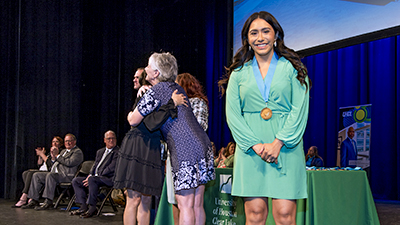
Shared Governance
Purpose
University of Houston-Clear Lake's Shared Governance System (SGS) is a participatory, advisory system charged with supporting the university's mission. The SGS provides a collaborative avenue through which the constituent groups advise the university's president on matters of policy and operations and assist in the development of procedures. The responsibilities of the SGS also include monitoring and overseeing the implementation of policies and procedures.
The Governance Process
Governance refers to the process of policy making and macro-level decision making within an institution. Governance, academic or non-academic, is defined as the manner in which issues affecting the entire institution, or one or more constituents, are decided. Constituent groups are expected to handle their internal affairs and every item need not go through the shared governance process.
The SGS shall consist of three layers, including the following committees and their subcommittees:
- Primary: University Council (UC), The UC will direct a review of the University Shared Governance Policy every five years.
- Secondary: Academic Council (AC), University Life Committee (ULC), Planning and Budgeting Committee (PBC) AND Facilities and Support Services Committee (FSSC).
- Subcommittees: Subcommittees can be established by any Secondary SGS committee as it deems appropriate.
The University Council will direct a review of the University Shared Governance Policy every five years.
Committee Recommendations
- Policy or proposal/initiative introductions
- Any policy introductions should be done in compliance with UHCL MAP 01.A.01 – Administrative Policy Creation, Revision and Retirement
- Procedures.
- Any member of any constituent group or any person at UHCL may introduce a proposal
or initiative or other items into the SGS structure. The chair of that SGS committee
will be notified and the chair may:
- Place the item on the committee’s next available meeting agenda
- Return the item to the person or group with notice that the item is not an SGS concerns
- Route the item to the appropriate SGS committee – or
- Inform the person or group that the items need further development before being introduced into the SGS
- Any member of any constituent group or any person at UHCL may introduce a proposal
or initiative or other items into the SGS structure. The chair of that SGS committee
will be notified and the chair may:
- Committee recommendations may be forwarded to the appropriate person or committee with a recommendation of support, no recommendation, or a recommendation of non-support, with detail notes on what specific elements of the proposal are recommended for amendment.
History of Shared Governance at UHCL
In the latter part of the 1980s, members of the UHCL Faculty Senate, with support from key administrators, constructed a new kind of shared governance in which consensus within the UHCL community of faculty, staff, students and administrators would produce policies and related procedures for operating the university. The university discussed the new system for a year, modified it, and accepted it. Five shared governance committees were established. All policies within the university entered the governance process and were approved according to the Faculty Senate Constitution.
A tenured faculty member who was elected by a vote of the faculty for a two-year term chaired each governance committee. Each committee had at least one representative from the Office of the Provost, one or two students from the Student Governance Association (SGA), one support staff representative from the Support Staff Association (SSA), one professional and administrative staff representative from the Professional and Administrative Staff Association (PASA), one representative of Administration and Finance, and at least four faculty members. Each college has at least one representative on each governance committee.
The shared governance system was based on consensus (majority of faculty and 60% of committee membership).






